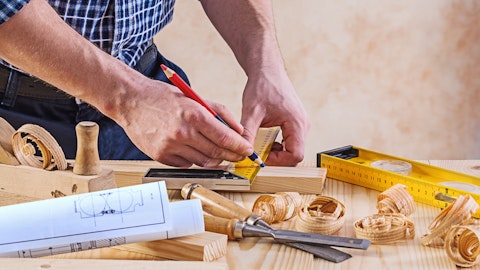Michael McKenney: Yes. You are right on your first assumption, Kurt. It really is predicated on us seeing strengthening in the capital bookings as we go forward.
Kurt Yinger: Okay. Got it. And then one of kind of the bright spots this year, I think, has been parts and consumables. And it’s had a steady performance despite some choppiness in some of the end markets, containerboard being kind of a big one. I mean we haven’t yet seen a lot of those trends really improved very much. Is there any concern that that could catch up and start to weigh on parts and consumables going forward? Or do you expect the solid performance in 2023 sets you up pretty well for 2024 as well?
Jeffrey Powell: It’s interesting. When you think of our parts, of course, it’s through the — all of our businesses have it. But in particular, we’re expecting a big recovery on the containerboard side this year. So they think containerboard was probably flat last year, and it was down for the first time, demand, I’m talking about was down for the first time in a very long time in ’22. But they’re forecasting containerboard demand increased 4.3% this year. Tissue to be up 4% this year and then even ’25, 3.8% for tissue and 3.7% containerboard. So we’re really expecting to see a recovery on that side of the business. And I would say also on the wood processing side, things have slowed down. Of course, housing starts were, I think, about 1.46 last month, but permits were about 1.5. So we are starting to see some improvement there.
And certainly, if interest rates start to come down, there’s tremendous pent-up demand for housing. And we have a lot of activity going on with our customers, a lot of discussions about projects. They’re really trying to get ready for what they think will be a pretty robust improvement in the market demand once interest rates start to decline. So I think it’s our belief that the parts business actually could continue to strengthen throughout the year, assuming things go as most economists are currently forecasting.
Kurt Yinger: Right. Okay. And I guess sticking with the wood piece, I mean there was a lot of capacity added. And to your point, I think there’s a lot of optimism that demand is going to continue to improve. But at the same time, some of that new capacity is being absorbed. I guess as you think about your capital equipment, how important is new greenfield facilities and new capacity versus just better utilization at existing facilities in terms of the overall kind of sales and demand picture for wood processing?
Jeffrey Powell: Yes. I think there’s both. And of course, because we’re global, and we have an extremely high market share, globally, it varies. So if you look at North America, it may be more just upgrading tired equipment. The average age of a lot of the equipment out there is pretty old. And so there’s just upgrading. But then there’s a lot of new greenfields going on in Asia, in particular. Our stranding guys are very busy in Asia. A lot of projects, a lot of activity. We booked another order in China a few weeks ago. And then you’ve got the situation in Russia. A lot of product came out of Russia. And of course, that’s got to be replaced now. So we’re seeing activity in Europe and in particularly, in Scandinavia area as they start to invest to offset the lost supply out of Russia.
So the wood side, it really depends on the region you’re looking at. But I would say the activity level right now is as high as it was before the pandemic for us with the tired equipment out there. And frankly, more and more, in particular, on the stranding side, more and more products using stranded material. That’s held up extremely well for us, and demand still looks quite good.
Kurt Yinger: Got it. Thanks for that Jeff. And then just my last one, I guess, bigger picture. You’re coming off two of kind of your strongest organic growth years in ’21 and ’22. This past year was still very solid as well. I mean where do you think the business is from kind of a cyclical standpoint entering ’24? And I guess is there anything that’s changed in terms of how you think about the organic growth profile of the business longer term relative to what you’ve kind of outlined in the past?
Jeffrey Powell: Well, we had — as you know, we had tremendous organic growth from, say, kind of ’18, ’19 on. It was — we were — I think 7.5%?
Michael McKenney: Yes.


